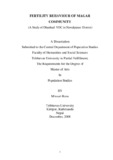Please use this identifier to cite or link to this item:
https://elibrary.tucl.edu.np/handle/123456789/3426| Title: | Fertility Behaviour of Magar community (A Study of Dhaubadi VDC in Nawalparasi District) |
| Authors: | Rana, Minsari |
| Keywords: | Fertility;Education;Child Mortality;Household |
| Issue Date: | 2008 |
| Publisher: | Department of Population Studies |
| Institute Name: | Central Department of Population Studies |
| Level: | Masters |
| Abstract: | his study deals with the "Fertility Behaviour of Magar Community".Theprimary data was collected from the study of Magar Community of DhaudadiVDC. The analysis and interpretation of data were carried out by usingfrequency tables, cross tabulation, mean CEB with selected dependent andindependent variables. The study included 120 married women of reproductive age group from thesame number of households. Out of the total population, 50.2 percent are malesand 49.8 females with the sex ratio of 100.9. Among the total population of 677aged 6 years and above, 61.8 percent of both sexes are found to be literate andremaining 38.2 percent are found illiterate. Similarly, among the totalpopulation aged 6 years and above, 35.3 percent are involved in agriculture inboth sexes. Likewise, among the total Population aged 10 years and above,58.4 percent people are found married against 38.2 percent unmarried and 3.2percent are found widow/widower. Average number of children ever bornamong married women aged 15-49 years is found 2.73. Occupational status anduse of contraception are found negatively associated with fertility. The majorityof respondents are found literate. Even the majority of the respondents arefound they are totally unknown regarding the overall situation i.e. political,social as well as the economic condition of the country due to the lack ofawareness. The longer duration of marriage is seen playing a significant role in increasingthe number of CEB. The education of women seems playing an important rolein decreasing the mean number of CEB in the study area. Women showingilliterate women having high CEB. Occupation has also seen playing animportant role for the reduction of fertility. Most of the women are engaged inagriculture in the study area and HH works, so they are found to have children,which mean higher fertility. Similarly income is also important cause ofincrease fertility. Higher the level of income, lower the CEB is found in the 5 study area. The income of majority respondent's isless than Rs. 1000 per moth.Similarly the mean CEB of low-income respondents had shown as higher thanthat of high-income respondents. Knowledge and use of family planningmethods especially female method are found high. There is high level ofcontraceptive use only after the first birth. This indicates that couple tends togive first birth soon after marriage. |
| URI: | http://elibrary.tucl.edu.np/handle/123456789/3426 |
| Appears in Collections: | Population Studies |
Files in This Item:
| File | Description | Size | Format | |
|---|---|---|---|---|
| thesis.pdf | 277.23 kB | Adobe PDF |  View/Open |
Items in DSpace are protected by copyright, with all rights reserved, unless otherwise indicated.
